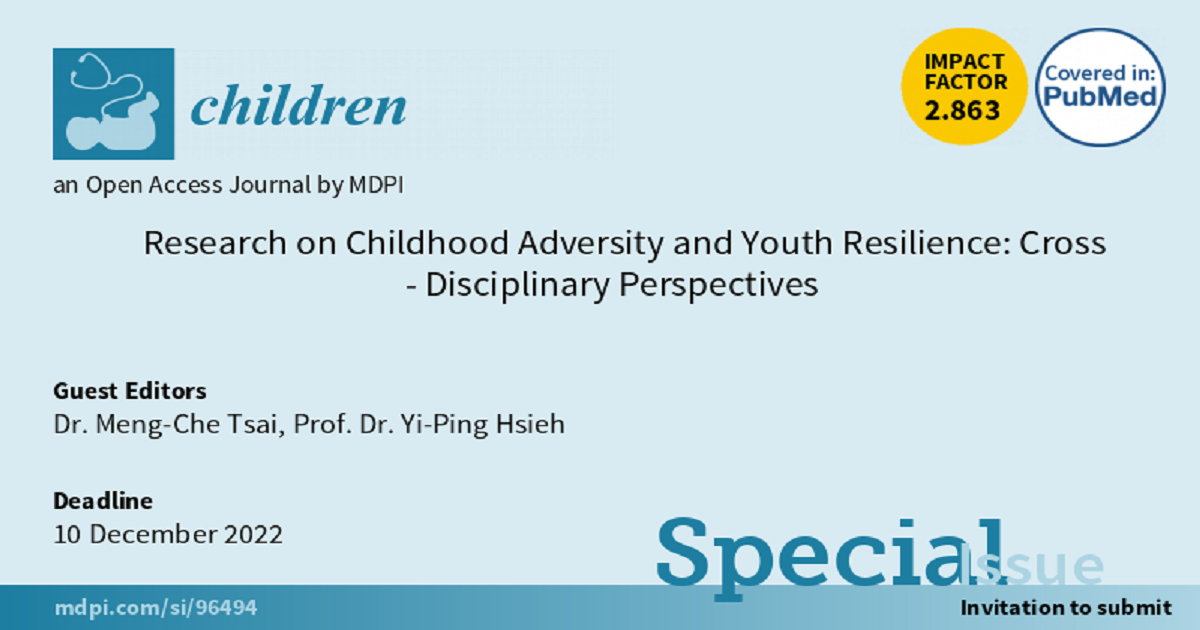Research on Childhood Adversity and Youth Resilience: Cross-Disciplinary Perspectives
A special issue of Children (ISSN 2227-9067). This special issue belongs to the section "Global Pediatric Health".
Deadline for manuscript submissions: closed (10 December 2022) | Viewed by 64512

Special Issue Editors
Interests: adolescent development; health behaviors; gene–environment Interaction; youth resilience; childhood adversity; social and behavioral medicine; developmental psychology; obesity; children’s growth and nutrition
Interests: internet addiction; cyberbullying; online safety; cybercrime; child abuse and neglect; parenting; cultural value and practice; bullying; victimization; violence against women and children; mental health and behavioral problems of children and youth; quantitative research methods; longitudinal data analysis
Special Issues, Collections and Topics in MDPI journals
Special Issue Information
Dear Colleagues,
Various forms of adverse childhood experiences (ACEs, e.g., disrupted family function, household financial strains, bullying victimization, maltreatment, and trauma) may have a negative impact on the physical health, mental wellbeing, and behavioral and social development of children and adolescents. However, individuals’ characteristics along with social resources and protective factors can help develop resilience and ability to thrive, despite exposure to ACEs. Potential protective factors may include children’s biological or developmental characteristics, as well as characteristics related to their family, school/peers, community, culture, and system, acting as buffers against the negative impacts of ACEs on children’s psychosocial wellbeing. Understanding the mechanistic interplay between types, timing, duration, and severity of ACEs, embodied within individual differences in genetic makeup, sociocultural backgrounds, and physiological conditions, may inform factors related to psychological resilience against negative outcomes. This Special Issue aims to highlight the importance of recognizing ACEs and traumatic events and their impacts as intervention targets in order to help children develop resilience and thrive despite ACEs. Thus, we would like to invite comprehensive reviews, original articles, and case reports with a particular focus on ACEs and youth resilience from a medical, nutritional, psychological, psychiatric or social perspective.
Prof. Dr. Meng-Che Tsai
Prof. Dr. Yi-Ping Hsieh
Guest Editors
Manuscript Submission Information
Manuscripts should be submitted online at www.mdpi.com by registering and logging in to this website. Once you are registered, click here to go to the submission form. Manuscripts can be submitted until the deadline. All submissions that pass pre-check are peer-reviewed. Accepted papers will be published continuously in the journal (as soon as accepted) and will be listed together on the special issue website. Research articles, review articles as well as short communications are invited. For planned papers, a title and short abstract (about 250 words) can be sent to the Editorial Office for assessment.
Submitted manuscripts should not have been published previously, nor be under consideration for publication elsewhere (except conference proceedings papers). All manuscripts are thoroughly refereed through a single-blind peer-review process. A guide for authors and other relevant information for submission of manuscripts is available on the Instructions for Authors page. Children is an international peer-reviewed open access monthly journal published by MDPI.
Please visit the Instructions for Authors page before submitting a manuscript. The Article Processing Charge (APC) for publication in this open access journal is 2400 CHF (Swiss Francs). Submitted papers should be well formatted and use good English. Authors may use MDPI's English editing service prior to publication or during author revisions.
Keywords
- adverse childhood experience
- traumatic events
- maltreatment
- bullying
- psychological wellbeing
- behavior problems
- child social development
- resilience
- intervention
- protective factors
Benefits of Publishing in a Special Issue
- Ease of navigation: Grouping papers by topic helps scholars navigate broad scope journals more efficiently.
- Greater discoverability: Special Issues support the reach and impact of scientific research. Articles in Special Issues are more discoverable and cited more frequently.
- Expansion of research network: Special Issues facilitate connections among authors, fostering scientific collaborations.
- External promotion: Articles in Special Issues are often promoted through the journal's social media, increasing their visibility.
- Reprint: MDPI Books provides the opportunity to republish successful Special Issues in book format, both online and in print.
Further information on MDPI's Special Issue policies can be found here.







